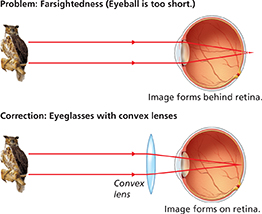Figure 19 Farsightedness occurs when an image is not focused before it reaches the retina. Farsightedness can be corrected by using a converging (convex) lens in front of the eye. Comparing and Contrasting In what ways are farsightedness and nearsightedness similar?
 d
dFarsightedness
Blurred images can also be a result of farsightedness. Farsightedness is a condition that causes nearby objects to appear blurry. Common causes of farsightedness are either a cornea that is not curved enough or an eyeball that is too short. In either case, the rays of light focus too far from the lens. As a result, the image focuses beyond the retina. A farsighted person can see distant objects clearly, but nearby objects seem blurred. Farsightedness is usually corrected by placing a converging (convex) lens in front of the eye. The lens bends the light rays toward each other before they enter the eye. Because the rays entering the eye are converging, the image is formed on the retina instead of behind the retina. Figure 19 shows a diagram of a farsighted eye and how it can be corrected.
Astigmatism
For clear vision, the lens of the eye and the cornea must be properly shaped. When the cornea or lens is misshapen, a defect in vision called astigmatism results. Astigmatism is a condition in which objects at any distance appear blurry because the cornea or lens is misshapen. Just as with an eyeball that is too long or too short, this irregularity can prevent light from focusing properly on the retina. The result is that the lens has two different focal points, causing distortion or blurring of the image. Specialized eyeglass lens shapes are used to correct astigmatism.
Section 19.4 Assessment
Reviewing Concepts
 List, in order, the parts of the eye that light encounters.
List, in order, the parts of the eye that light encounters. What are three common problems that affect vision?
What are three common problems that affect vision?What is the eye's blind spot?
Which kind of lens can correct nearsightedness? Farsightedness?
Critical Thinking
Inferring Why is the cornea transparent?
Comparing and Contrasting How is the structure of the eye similar to that of a simple camera?
Making Judgments Suppose that when you sit at the back of the room, you can't read the chalkboard. What vision problem might you have?
Connecting Concepts The index of refraction of the cornea is about the same as that of water. Use this fact to explain why you cannot see as well in water as in air.
Writing in Science
Steps in a Process Write a paragraph describing how a light ray passes through the eye and results in vision.




